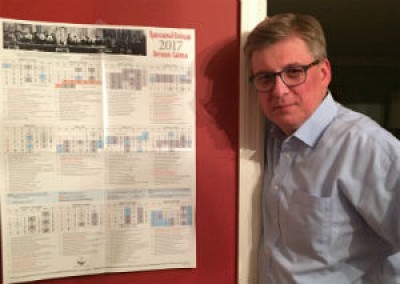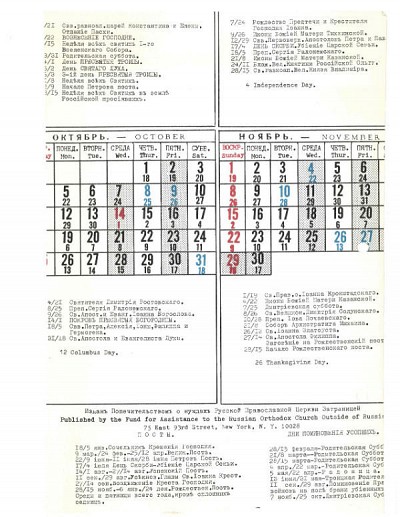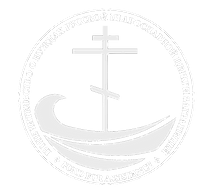
|
Peter Fekula poses in front of the 2017 Liturgical Calendar he was responsible for putting together. |
For many years the Fund for Assistanceto ROCOR has been putting together and sending out thousands of liturgical calendars to its supporters. The calendar - printed in English and Russian - offers as much liturgical insight into the practical life of the Church as possible to put into one sheet: lenten and meat days, popular saints' commemoration days, feasts and fasts... There is a reason the calendar is popular in 17 countries. Find out why - in this interview with Peter Fekula, the director of the Synodal Choir in New York City, and specialist in Orthodox Rubrics, and get your own calendar here. All proceeds go to the support of the Church.
Peter Fekula: For years, the calendar was prepared by Fr. Sergiy Kargai; this was a long, long time ago. And then he passed it on to Yuri Illiodorovich Schidlovsky who was the chairman and president of the FFA for many years. I began working on it with him pretty much when he started working on it. So, I’ve probably been working on the calendar now since the early ‘90s, maybe?
We used to have a ritual. He would scope it out initially, and then I would take over and I would make sure all the dates were in the right places and the fasts were in the right places – and that’s a whole special thing we can talk about. Obviously, the calendar changes year to year because Pascha moves around and that has significant impact on the first half of the year. I would send him a draft and he would put it into the computer. He had a whole little setup in the basement of his house. And then I would go to his house a couple of times and his wife, Sophia Konstantinovna, would make soup and tea, and we’d have soup and tea and we’d do the calendar together.
When he fell ill, and eventually he died, it went over to Fr. Evgeniy Kallaur. And he and I have been working on it now together – well, first it went to Yura Podelsky and then it went to Fr. Evgeniy, and Fr. Evgeniy and I have been working on it now probably for the last four or five years. So, yeah, I’ve been involved in the calendar for probably twenty-five years by now, doing it every year. It’s actually a wonderful thing. First of all, I think it’s useful for people, I think it helps give a clear picture of the feasts and the pace of the year from the church calendar perspective. It helps people plan their lives around important religious events and commemorations, which is of course important in the Orthodox world.
FFA: How has the calendar changed over the years?
PF: Over the years, we’ve become more sensitive to anniversaries as they happen. It used to be more of here’s some pictures of some Russian schools or some summer camps and things like that or famous personages, but then we started to do things like this year’s calendar is dedicated to the hundredth anniversary of the local council, the Great Council, of the Russian church from 1917 – 1918, which was a seminal event in the church. It was the first council in the Russian church since the 17th century. Then we’ve had a year dedicated to anniversaries or years of some significant composers of Russian liturgical music. Last year was one thousand years of monasticism on Mount Athos, so significant, but sometimes neglected anniversaries of the Russian church and Russia in general and Russian culture and church culture. That’s one thing.
Another thing is we’ve become more careful about how we denote fasting days. It used to be there were just “no fasts,” “regular fasts,” and “strict fasts,” which is a very clunky way to denote fasting in the Russian church. So, many years ago by now, we’ve started to become a little bit more precise in how we indicate the different levels of fasting, whether it’s no fast, or a simple fast – which is a regular fast where wine and oil is allowed – then one where wine and oil is not allowed, and the strictest of fasts or fasts where fish is allowed. And that’s actually the most time-consuming element of the calendar because especially during what we call the lesser fasts – the Nativity Fast in November-December, and the Apostles’ Fast leading up to the feast day of Peter and Paul – those fasts are dependent on the day of the week and any kind of commemoration that may be coinciding, so during those fast days a fast on a Tuesday is less strict than a fast on a Wednesday, so it changes every year. And you have to coordinate that and you have to coordinate when events fall, like the Entry of the Theotokos into the Temple in December (new calendar), so all of that makes it a jigsaw puzzle that has to be put together.
FFA: What resources do you use to prepare the calendar?
PF: Generally, the resources that I have at hand are the Typikon of the church, which gives feast days and the order around that and the fasting rules, but I also coordinate with several people because I think it’s important that our calendar be coordinated with, for sure, other ROCOR endeavors.
So, I work every year with Fr. Roman Krassovsky, who is now the head of the Mission in Jerusalem in the Holy Land, and he has been putting together what everyone calls the “Jordanville Calendar” or the “Jordanville Typikon”, and he has been responsible for compiling and editing that for many years already. I always coordinate with him because it’s important, as I say, that we have unity with what we put forth, I think, as far as ROCOR calendars go. So, there is always a question about certain things: when do you celebrate the commemoration of the dead around St. Demetrius’ day in November? That can change a little bit depending on how you approach that day. So, I want to make sure that’s always together, I want to make sure that we’re all commemorating the feast days of the New Martyrs together, at the same time, and St. John of Shanghai, which are moveable feasts, so I just want to make sure that that works. And the other person I coordinate with is Daniel Olson and I always compare and work with him on the fasting days.
I spent many years working with Fr. Gregory Williams who just died last year and went into schism, unfortunately, about ten years ago. I used to work with him starting from the ‘80s translating the Jordanville Calendar into English for our English-language parishes, and then that whole endeavor became a lot more sophisticated: rather than just translating the Jordanville Calendar we began creating an annual typikon without relying on the Jordanville one.
So many things are driven by when Pascha falls and everything leading up to Pascha and everything from Pascha up until Trinity Sunday or even the Sunday of All Saints or the Sunday of Russian Saints after that. And that has an impact on certain events. For example, whenever Pascha is, if Annunciation falls in a certain place within that Paschal period or that Lenten period, that impacts when certain commemorations happen. Certain saints, if their day falls on a commemoration of something during the Lenten period, that saint’s commemoration may move. And you have to keep track of all that stuff, you just can’t say, “oh, this specific saint is always on this date,” because it might not always be on that date.
Mistakes do creep in; I’m kicking myself three years later for a mistake we made in the calendar a couple of years ago where we – It was my fault, we had – the Dormition of the Theotokos fell on a Friday, and I put a regular fast day instead of a day allowing for fish, which, of course, you can have fish on a Friday when Dormition falls! And it just was there, staring at me all year, that box, wrong box, and it made me so mad. So we do have mistakes, and I apologize to everybody for any mistakes that we have on the calendar!
FFA: What do you enjoy most about preparing the FFA calendar?
PF: First of all, I enjoy just at the very beginning when you start and you start putting the dates in their right places. For me, work on the calendar starts typically in May or June of the preceding year, and so I’m already now thinking the whole second half of a given year, I’m already thinking about what’s going to happen in the a year ahead because I’ve done the calendar. Stuff like that, it gives you a snapshot or a look into what’s in the future, and it prepares you for that.
I also really, really enjoy exploring the anniversaries. Some of the anniversaries come from the FFA and the directors – like the whole idea of the hundredth anniversary of the Council; I thought it was a great, great decision. Some of the anniversaries come from Fr. Roman who puts some thought into that, and some of the anniversaries we’ve got to come up with myself, and offer it up as a possibility for the board to consider. I think that’s very important because it connects you to things. If you know that this is the fifteen hundredth anniversary of the martyrdom of this saint, well, that’s important. I think if you allow people to be attuned to the changes in the calendar from year to year and how the fast falls and Pascha falls and where a specific saint might get a special commemoration because it’s some important anniversary, I think that’s important because it means that our church is a living thing. It’s a church that lives in the present, of course, which is what the calendar does, it shows you what the present is, but it also connects you to a very significant and rich past and I think that’s important.
FFA: The FFA calendar is sent to 17 countries every year. Why do you think it is popular?
PF: You know, if the calendar is useful in so many countries, should we have versions that are translated into more languages than we have right now? Right now it’s in Russian and English. Is there a need, and would people who speak neither of those languages find use out of the calendar and obtain it every year if it was in their language? Should we have a Russian – I think Russian should always be there. Should we have a Russian-French version, a Russian-German version, a Russian-Spanish version, and a Russian--- I don’t know! That raises the question and certainly magnifies significantly the complexity of the undertaking because right now, it’s very easy – I speak Russian, I speak English, I can put the calendar together. I’m not so fluent in other languages and I think we would have to enlist the help of French speakers, German speakers, whatever, and everything would have to get done several months earlier so that the file could be sent to them and their translations could be made. But it’s something to consider.
FFA: Why is the calendar in Old Orthography Russian?
PF: I’m glad you asked that question and I wonder if that’s something that people complain about or not. It would be easier, in some ways, to do it in new orthography because you‘d have a little bit more space, because you don’t have to put the hard sign, things like that in there. But Old Orthography, to me, shouldn’t be looked upon as some musty old thing. When the orthography changed, it broke written Russian from its roots in an older form of Russian Slavonic. But I think it says something about our calendar, too, and the history of our calendar and where our calendar comes from.
FFA: Why is the calendar popular?
PF: Well, I think a few reasons. I think people, for whom it’s important, use the calendar to plan their life a little. You can look at the calendar and say, “ok, this is a good time to take a vacation,” or, “this is not a good time to take a vacation.” I think it also helps people remember when Namesdays are. In the calendar we list the saint’s days of, I don’t want to call them “popular” saints, but saints who have a lot of people named after them. So you can look that up and make a little mark and remember, “oh, I have to congratulate dyadya Kolya or tyotya Masha because their Saint’s day (Именины) is coming up,” and I think that’s a useful function. But really, I think it also just tells people when important events are happening in the church year and they know when they should be aware of that.
I think if you look at the calendar as it is, and even if you then compare it to a previous year’s calendar, you can begin to gain an understanding of things that are important in the church year. And I think that will connect you to the church a little bit more, and to the life of the church, and the rhythm of the church. The calendar is a stepping-stone into perhaps a deeper understanding of the church life.
FFA: What are some of the best comments that you’ve heard about the calendar over the years?
PF: It’s interesting. We always get comments from people that are grateful. I don’t actually see very many of those anymore. But Yuri Illiodorovich, we lived very close to each other and so we would go to the church together and say, “oh, I got an email from somebody who thought this was great about the calendar.” People also complain. We’ve had complaints about some of the fast dates not being right or not what people are used to. We had one complaint from somebody asking why do we start our calendar with a Sunday rather than a Monday, because in Russia, I think, calendars start with Monday and end on a Sunday.
One comment we got, we showed that Nativity is only celebrated on one day, like the Jews celebrate it, which I thought was a very funny comment because first of all we don’t have it for just one day in red, we have it for three days in red, but the Jews don’t celebrate Nativity at all.
FFA: What would you like to do for the calendar in the future?
PF: I’d like the calendar to continue to be a living thing. It’s a useful resource for people who want to learn more, and I want to make sure that it continues to be one.
|




